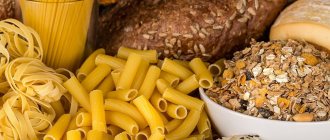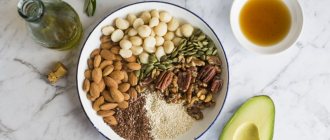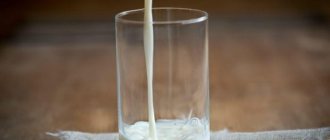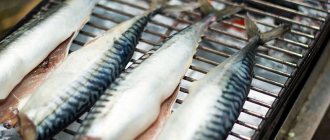General information about unsaturated fats
Unsaturated fats are triglycerides of fatty acids, which include 3 different types of acid residues. Their main sources are seafood, vegetable oils, nuts, and oilseeds.
Chemical structure
In molecules there is at least 1 double bond between carbon atoms.
Trans or cis isomers are formed in fat molecules. In the first case, the hydrogen atoms are located on opposite sides of the carbon bond, so a rigid structure is formed. To melt such substances, high temperatures are required. Most healthy fats have a cis configuration. It involves placing hydrogen on one side of the carbon skeleton, which causes the molecule to bend. Such molecules have a less stable structure and are more susceptible to catabolism. A large number of double carbon bonds leads to rapid oxidation of the substance.
Being in nature
Vegetable oil is considered the main source of omega-9. The product is obtained from oilseeds: rapeseed, sunflower, olive tree. Sometimes oily liquid is a by-product during the processing of industrial plants (flax, cotton, mustard). Monounsaturated fatty acids (MUFAs) are found in nuts, avocados and seeds. Omega-3 and omega-6 are found in ocean and sea fish. They are found in caviar, eggs, chicken meat, and grape seeds.
Omega-9 is found in many types of vegetable oil.
Monounsaturated fats in cosmetology
In cosmetology, the most popular is oleic acid, which is found in olive oil. The plant concentrate is used both in pure form and as part of creams, shampoos, masks, and shower gels. Olive oil is used to care for dry, dull and sensitive skin.
Functions of oleic acid:
- moisturizes and nourishes the epidermis;
- potentiates the secretion of the sebaceous glands, preventing the appearance of dandruff;
- prevents the formation of new wrinkles;
- improves facial tone;
- prevents skin aging;
- normalizes lipid metabolism in the dermis, preventing the development of cellulite;
- holds water molecules in dermal cells;
- improves the functional condition of the scalp, reduces hair loss and fragility;
- reduces the risk of developing skin tumors, including after sunbathing or visiting a solarium.
Considering that oil molecules deliver essential substances to the deep layers of the skin, olive oil is used as a component of salon spa treatments, massages, wraps, baths, and rejuvenating programs. In addition, the concentrate is used during trips to the sea or trips to hot countries to protect and mitigate the effects of the aggressive effects of the sun and water on the skin.
Main rules of care:
- For cosmetic purposes, choose cold-pressed (unrefined) oil.
- The product is applied only to damp skin.
- The maximum period for using an open bottle of oil is 14-20 days. If after three weeks it is not replaced with another composition, a protective film forms on the face, which prevents the skin from breathing freely. As a result, pores become clogged, which leads to the appearance of comedones, blackheads, and blackheads.
- To lighten the complexion, add a drop of lemon juice to the unrefined oil.
- For those with oily skin, the product can only be used as part of cosmetics that contain citrus fruit extracts or esters.
- After using fatty olive oil-based formulations, do not use a moisturizer.
- To identify allergic reactions, the product is applied to the elbow for 15 minutes. If there are no unpleasant sensations (rash, itching) at the site of application, it can be used on an ongoing basis.
- After cleansing your skin with olive oil, you need to wash your face with warm water and lemon juice.
If you follow these tips, you will be able to get the maximum benefit from the external use of unsaturated fats.
Effect on the human body
Polyunsaturated acids are necessary for the functioning of membranes, organ membranes, and connective tissue. They ensure normal fetal development, prevent fat accumulation, and reduce the concentration of stress hormones.
Critical for fetal development during pregnancy
Taking omega-3 and omega-6 is important in the first and third trimesters, as they prevent the occurrence of pathologies in the fetus. They maintain normal blood circulation in the placenta so that the baby receives the necessary vitamins, amino acids, and minerals. Docosahexagenic acid is responsible for the formation of brain matter and vision development in a child.
Children who receive the required amount of polyunsaturated fats are distinguished by more developed motor skills, coordination, and intellectual abilities.
Reduce blood pressure
The hypotensive effect is achieved due to the formation of prostaglandins, which affect vascular tone. The amount of adenosine in the brain decreases. Polyunsaturated fats help reduce the level of stress hormones in the blood and the concentration of calcium ions in cells. As a result of these processes, the elasticity of blood vessels improves. They expand, so blood pressure normalizes.
Reduce triglyceride levels in the blood
PUFAs regulate fat metabolism in the body. They slow down the synthesis of triglycerides and lipoproteins and prevent them from accumulating in adipose tissue. It is enough to consume about 4 g of fish oil every day to reduce the level of these organic substances in the blood by 25-35%.
PUFAs reduce the concentration of triglycerides in the blood.
Improves depression and ADHD
Omega-6 and omega-3 have positive effects on people with attention deficit hyperactivity disorder (ADHD). These substances reduce the frequency of symptoms of the disease by 25% and alleviate them. They control serotonin levels, therefore reducing the risk of depression. But the best effect is observed when combining essential fats with antidepressants.
Beneficial features
The main function of monounsaturated lipids is the activation of metabolic processes in the human body.
Other positive properties of MUFA:
- prevent the adhesion of atherosclerotic plaques to the walls of blood vessels, reducing the risk of heart attack, stroke and atherosclerosis;
- participate in the mechanisms of building cell membranes (as structural elements);
- stimulate bile secretion;
- improve the functional state of the skin (by stimulating the renewal of intercellular substance);
- break down saturated fats that come with food;
- normalize the permeability of cell membranes;
- potentiate the utilization (burning) of fat deposits;
- reduce the risk of developing insulin resistance;
- inhibit the development of malignant neoplasms;
- stimulate the immune system (due to the presence of phenolic compounds exhibiting antioxidant properties);
- potentiate the synthesis of prostaglandins;
- prevent constipation;
- protect liver cells from the toxic effects of alcohol and lead compounds;
- activate the synthesis of their own collagen, hyaluronic acid, elastane, glycosaminoglycans.
In addition, unsaturated fats, in particular palmitoleic and oleic acids, exhibit cardioprotective properties. Due to this, they are used in complex therapy for the treatment of cardiovascular and autoimmune pathologies.
Foods containing unsaturated fats
The main source of polyunsaturated acids is fish and seafood. Monounsaturated fats predominate in vegetable oils and oilseeds.
Fish
Fish is a rich source of omega-3. In different types, the content of this substance is (in g per 50 g serving):
- salmon - 1.29;
- herring - 1.21;
- mackerel - from 0.81 to 1.34;
- tuna - 0.82;
- sardines - 0.74;
- trout - 0.53;
- cod - 0.11.
Omega-3 content in different types of fish.
Red and black caviar are characterized by a high concentration of PUFAs (4 g per 50 g of product). The amount of nutrients depends on the habitat of the fish. Marine species that feed on algae are rich in alpha-linoleic acid and contain some omega-6. But in river varieties, the concentration of the latter increases by 13-15 times, and eicosapentaenoic alpha-linoleic acid is less.
Seafood
Seafood is a good alternative to fish in your diet, as it contains a lot of polyunsaturated fats. The leaders in their quantity are considered to be oysters, conger eel, shrimp, scallops, and clams. Additionally, they contain some omega-6 acids.
Vegetable oils
They are dominated by linoleic and arachidonic acids. More of these fats are concentrated in the unrefined product. The following oils have a high concentration of these substances (in g per 50 g of liquid):
- poppy - 36.4;
- sunflower - 30.5;
- hemp - 26.4;
- soybean - 25.7;
- cotton - 25.4;
- sesame - 20.
Fat content in unrefined oils.
Unrefined olive oil contains omega-9 acids (38.7 g). The flax-based product stands out especially. It is high in alpha-linoleic acid (about 28 g) and low in other unsaturated fats.
Nuts and oil seeds
When consuming nuts daily, the body receives a portion of omega-6 and omega-9 acids. The former are found in walnuts and pine nuts, pecans, peanuts, and pistachios. Macadamia nuts, hazelnuts, almonds, and cashews are considered rich in monounsaturated fats. Among oilseeds, the highest concentration of these substances is typical for sunflower seeds and sesame. Some PUFAs are found in cotton seeds, rapeseed, flax, pumpkin, mustard and soybeans.
Meat and eggs
Raw chicken yolk is considered a source of fatty acids. These beneficial substances are found in duck, goose, and quail eggs. Meat contains little of them. Healthy fats are present in rabbit, pork, goose and chicken. Foie gras, duck, lamb, and veal include MUFA.
Polyunsaturated fats are found in turkey skin, beef brisket and brain.
Vegetables
They are not rich in fatty acids. There are no monounsaturated fats in vegetables. A small amount of PUFAs (up to 0.3 g per 100 g) is found in ginger, corn, garlic, broccoli, kale, Brussels sprouts and cauliflower. Some of these substances are present in greens (quinoa, arugula, chives, watercress, parsley).
General information
A distinctive feature of monounsaturated fats is their ability to change structure when the temperature drops. So, at 10-25 degrees Celsius, lipids are in a liquid state, and at 0-5 degrees they solidify. In addition, MUFAs are more resistant to oxidation than essential fatty acids (alpha-linolenic, eicosapentaenoic, docosahexaenoic, linoleic).
Content:
- General information
- Beneficial features
- Daily norm
- Food sources
- Beware of erucic acid!
- Monounsaturated fats in cosmetology
- Conclusion
The main representative of monounsaturated lipids is oleic acid. Its maximum amount is found in olive oil. This concentrate is suitable for frying foods because it does not release carcinogenic substances when heated.
Other representatives of unsaturated triglycerides: erucic acid (omega-9), myristoleic acid (omega-5), eicosenoic acid (omega-9), palmitoleic acid (omega-7), elaidic acid (omega-9), aceterucic acid (omega-9). 9).
Not all monounsaturated lipids are beneficial for humans. Thus, erucic acid, due to its metabolic characteristics, has a negative effect on the heart muscle.
Daily requirement
The daily intake of these substances depends on the state of health, work activity and place of residence. For a healthy person, it is enough to consume from 50 to 80 g of unsaturated fats (20% of all calories).
Daily intake of healthy fats.
In case of exhaustion or illness, their amount is increased to 100 g. For those living in the middle latitudes of Russia, the daily requirement increases to 30%, in the North - to 40% of the calorie intake. If a person’s work involves heavy physical labor, the share of these substances in the diet should be at least 35%.
Everything you need to know about dietary fats
In the interests of good health, fats used in cooking and in food should not be avoided, but choices should be made about which ones are preferable and consumed in moderation. Today's food is full of animal fats, from which we get too many saturated fatty acids. And if we eat too much processed food, we end up with excess amounts of harmful trans fatty acids. The latter should be present in food in limited quantities, as far as possible.
Why do we need fat?
Our body is made up of approximately 3 trillion cells that need fatty acids to function properly. There is no place in the human body in which there are no cells - bone marrow cells, blood cells, brain cells, nerve cells, muscle cells, skin cells, etc. To function effectively, they all need nutrients - proteins, carbohydrates and fats. Especially cell membranes, i.e. shells, need omega fatty acids. For example, our brain is composed primarily of fat.
What fatty acids are found in dietary fats?
Dietary fats contain three types of fatty acids:
- saturated fatty acids;
- monounsaturated fatty acids;
- polyunsaturated fatty acids.
What are the types of saturated fatty acids?
Saturated fatty acids predominate in animal fats such as lard and mayonnaise. Animal fats usually have a solid consistency at room temperature. If a person consumes a lot of solid fats, then cell membranes become more rigid, which disrupts the metabolism between cells. Nutrients will not be able to enter the cell, and residues will not be properly eliminated from the body. The ability of cells to communicate with each other will also decrease. Saturated fatty acids are also found in meat products, in the form of visible and invisible fats (eg sausages, sausages, bacon). Also in very fatty dairy products (cream, fatty cheeses, butter), as well as in most baked goods. Saturated fats are mainly used in the body for energy production, and unused solid excess fats are stored in the body in the abdomen, thighs, buttocks and so on.
What are monounsaturated and polyunsaturated fatty acids?
Mono- and polyunsaturated fatty acids predominate to a greater extent in vegetable fats such as olive and rapeseed oil. Unsaturated fatty acids are, for example, omega-3, 6 and 9.
Polyunsaturated fatty acids (healthy fats), such as essential fats:
- Alpha-linolenic acid, or ALA, or omega-3
- Linoleic acid, or omega-6.
The human body is not able to produce omega 3 and 6 on its own. Therefore, they must be obtained through food. The body does not use healthy fats to produce energy. It uses them, for example, to build new cells and hormones.
Omega-9 monounsaturated fatty acid, or oleic acid,
present in olive oil. Olive oil also contains antioxidants, which is why it is considered beneficial for the cardiovascular system. Olive oil plays an important role as a cell builder and is also essential for people suffering from heart disease. Monounsaturated fatty acids are found in nuts, seeds and avocados, which are very healthy sources of fatty acids. Regular consumption of nuts improves blood sugar balance, reduces the risks of diabetes, cancer and obesity.
Sources of Omega 6 (inflammatory agents)
Omega-6 fatty acid is found in fish, pork and chicken. If we consider it in the context of vegetable fats, it is found in grape seed oil, pumpkin oil, sunflower oil and rapeseed oil. Omega-6 helps stimulate the inflammatory process, which is the body's natural defense against aggressors. This could be some bacteria, toxic substances, viruses, or, for example, the surface of the fingers. The inflammatory cycle is an ideal way to protect the body from dangerous bacteria and viruses.
Excessive amounts of omega-6 in our cells contribute to inflammatory processes in the body. Therefore, chronic cell inflammation may begin. Chronic inflammation is very harmful, while acute inflammation is beneficial. The main causative agent of chronic inflammation is excessive consumption of simple refined carbohydrates (sugar, flour and products containing them). Also, excess vegetable fats (which include soybean, corn and sunflower oils). In addition, animal meat soaked in plant and animal flour. These are the nutrients that make up most of our daily diet. Among other things, such products include fish grown in artificial conditions, which ate unnatural food.
Omega-3 Sources (Inflammation Fighting Sources)
Chia seeds, flax seeds, cannabis seeds, cedar seeds, soybeans, rapeseed seeds, and walnuts are considered rich in omega-3 fatty acids.
The human body modifies the omega-3 alpha-linolenic acid found in the seeds into:
- EPA (eicosapentaenoic acid) and DHA (docosahexaenoic acid), or higher omega-3 fatty acid, from which many tissue hormones are formed.
Alpha-linolenic acid → EPA, DHA
Most important source of EPA and DHA
In finished form, we can only get the fatty acids DHA and EPA from sea fish (fish oil)!
The most important source of omega-3 is fish, and EPA and DHA are highest in small deep-sea fish such as anchovies and mackerel.
since they are not contaminated with heavy metals (unlike large fish).
Omega-3 is also present in large quantities in salmon, trout, tuna and herring
.
A recent discovery is that the body cannot adequately cope with the modification of alpha-linoleic acid into EPA and DHA. Especially during illnesses. Therefore, it is recommended to eat fish at least twice a week or take fish oil supplements.
Omega-3, omega-6 and inflammation
When the ratio of omega-3 to omega-6 fatty acids in the diet is in balance, the body produces an excess of anti-inflammatory eicosanoids.
If the amount of omega-6 fatty acids is too large, then
eicosanoids contribute to inflammatory processes.
For all types of tumors, heart disease and other inflammatory conditions, omega-3 rich fats can reduce inflammation. If a person consumes solid fats, trans fats, alcohol, and there is also a lack of zinc, vitamin B6 and magnesium, then the body cannot process plant omega-3s into EPA.
Omega-3 is renowned for its positive effects on the cardiovascular system, joints, brain function and memory. Also, on the quality of skin and hair, vision and efficient functioning of the whole body. Omega-3 fatty acids can lower blood pressure, as well as the level of cholesterol and “bad fats” in the blood. In addition, they fight diabetes, calcify blood vessels, and prevent the risks of growth of certain types of malignant cells.
With the balance of fatty acids, problems associated with cholesterol
, since it does not have the ability to be deposited on the walls of blood vessels without inflammation, thereby causing strokes and heart diseases. Without inflammation, cholesterol moves freely throughout the body, as nature intended. Inflammation is precisely the factor that contributes to the accumulation of this substance. But a person needs cholesterol in a certain amount, since it breaks down the inflamed surfaces of blood vessels.
Symptoms of Omega-3 Fatty Acid Deficiency:
- Feeling very tired
- Memory problems
- Dry skin and hair
- Heart problems
- Mood swings
- Metabolism problems
An imbalance of fatty acids can cause cardiovascular diseases, skin problems, and joint inflammation. Also, allergies, Alzheimer's disease, infertility, some forms of malignant diseases, hyperactivity, obesity and diabetes.
What should be the balanced ratio of omega-3 and omega-6?
The ideal ratio of omega-3 and omega-6 fatty acids for the human body is 1:1. It is in this form that our genes have developed over many centuries. Thanks to today's diet, we get 20-30 times more omega-6 than omega-3. Research shows that 85-90% of the population is deficient in omega-3 fatty acids. Today a ratio of 5:1 is considered acceptable. The average European's fatty acid balance is 15:1, and the American's is 50:1 in favor of omega-6. This indicator causes 70% of diseases of the cardiovascular system, as well as many others, no less serious.
What should you consider when purchasing healthy fats?
Today, fish oil no longer has such a rich fishy taste as many of us remember from the experience of past years. Modern fish oil even has a pleasant taste due to additives - you just need to make sure that they are natural. For this supplement, quality is of decisive importance.
Omega-3 fatty acids go bitter very quickly. Also, the fish from which they are obtained may be caught from polluted waters. In particular, predatory fish can accumulate large amounts of heavy metals over many years. When purchasing fish oil, make sure it is mixed with some oils (such as olive oil). They are rich in high-quality polyphenols and have antioxidant and anti-inflammatory effects. This prevents fish oil from becoming bitter. Olive oil is an excellent antioxidant, and the combination of these two components has a therapeutic effect. The best and purest fish oils with EPA and DHA come from deep sea fish (anchovies and mackerel).
Olive oil rich in polyphenols
Another important aspect regarding fish oil is the presence of other nutrients. For example, the EPA and DHA content of fish liver oil is relatively low. But from it we get a lot of vitamins A and D. At the same time, there are products in which fish liver oil is mixed with fish oil. Liver fat brands sell products that are higher in EPA and DHA. Typically, the EPA and DHA content of fish liver oil is higher than that of fish oil. But such information needs to be clarified when reading the product label. For example, a standard dose of one product may contain 885 mg of EPA and 590 mg of DHA, while another is significantly less - 165 and 110 mg, respectively.
What should the EPA to DHA ratio be?
Professor of Medicine at the American Mayo Clinic, Dr. Stefan Kopecky, recommends considering the formula 3:2 as the ratio of EPA and DHA, respectively, or vice versa. Studies have shown that DHA successfully outperforms EPA in reducing triglycerides and increasing levels of “good” cholesterol. EPA has been found to have the beneficial property of lowering the level of “bad” cholesterol. Both forms of omega-3 have positive anti-stress effects. DHA reduces aggression, and EPA acts as an antidepressant. Another source says that the amount of EPA is increased if it is necessary to have a beneficial effect on the cardiovascular system, and DHA - on the nervous system. One capsule of a quality product can contain at least 600 mg and 1000 mg of EPA and DHA.
How much fish oil should you consume?
The question of how much and what kind of fish oil to consume depends on the person’s health status. Also, the purpose of using a dietary supplement is important: treatment, disease prevention, or simply maintaining health. Although omega-3 fatty acids perform very important functions in the body, they are not stored in the body and are not converted into energy. Therefore, the body does not need large quantities of them. One tablespoon of omega-3 fatty acid oil per day can satisfy your body's needs. That is, 1500-2000 mg (obtained from products and taken), in the presence of tumors - 4000 mg.
Consuming fish oil in large quantities over a long period of time can lead to blood thinning. Therefore, the Department of Medicines only allows large doses of EPA and DHA to be taken as medicines. Total amounts starting from 2 g per day. These fatty acids are not recommended to be consumed in large doses until about a week before surgery and childbirth. They may also increase bleeding during menstruation.
NB! Check with your doctor if you are taking these medications, even if you are taking blood thinners.
Is it possible to measure the fatty acid content in your blood?
A package for measuring fatty acid levels can be ordered from the health testing laboratory MINU.SYNLAB.EE. The test should be done before you start taking the dietary supplement to see your own ratio of omega-3 to 6. Also, the test should be repeated after four months (120 days). During this time, the blood will have time to renew itself.
Sources:
- https://tervisekool.ee/tervisekool/failid/File/lugemist/s%C3%BCda/Soovitusi%20toidurasvade%20tarbimiseks.pdf
- https://www.toitumisterapeudid.ee/failid/File/konverentsid/s%C3%BCda/Rasvad%20Sirli.pdf
- https://toitumine.ee/energia-ja-toitainete-vajadused/pohitoitained/rasvad-sh-rasvhapped-ja-kolesterool
- https://www.paljasporgand.ee/koik-mida-rasvast-teadma-pead/
- https://et.wikipedia.org/wiki/Rasvad
- https://www.toitumisnoustaja.com/2012/11/head-rasvad/
- https://labdoor.com/article/epa-to-dha-ratio-a-benefits-and-risks-analysis
- https://www.fattyacidshub.com/fatty-acids/dha/fish-oil-epa-dha-ratio/
- https://en.wikipedia.org/wiki/Omega-3_fatty_acid
- https://www.looduspere.ee/blogi/miks-kvaliteetne-oliivioli-on-kibe/
Was this post helpful?
Let us know if you liked the post. That's the only way we can improve.
Signs of a lack of unsaturated fats in the body
With a lack of plant-based foods in the diet, a deficiency of unsaturated fats occurs. The following symptoms indicate a problem:
- slowdown in physical development;
- growth retardation;
- increased blood cholesterol levels;
- weight loss;
- violation of water metabolism;
- neutralization of the effect of vitamins B and C;
- failure in the exchange of tocopherol and retinol.
Due to the lack of these substances, the skin becomes dry, itching and flaking appear. The condition of hair and nails worsens. Redness and dry eyes are often observed. A person’s mood constantly changes, and he quickly feels tired and hungry.
Saturated fatty acids:
As a rule, these are animal fats. They have a solid consistency and a high melting point. Examples of animal saturated fats: lamb, beef, pork, chicken, milk and other fats. Sources of vegetable saturated fats are tropical oils (palm and palm kernel, coconut, cocoa butter).
All saturated fatty acids can be synthesized by the body (that is, their consumption with food is not necessary if polyunsaturated fatty acids are present in sufficient quantities in the diet). However, it is saturated fatty acids that are responsible for the pleasant taste and texture of food. Now it’s clear why we are so drawn to them!
What are the dangers of eating too much saturated fat?
(photo from open source)
Saturated fat increases the level of total cholesterol and low-density cholesterol ("bad" cholesterol) in the blood, which leads to the risk of atherosclerosis, type 2 diabetes, obesity, coronary heart disease (CHD) and increased overall mortality. For every percent increase in caloric intake due to saturated fatty acids in the blood serum, there is an increase in LDL (transport molecules of “bad” cholesterol) by 0.033-0.045 mmol/l, which is quite a lot. True, recently more and more studies confirm that sugar plays a greater role in the risk of developing coronary artery disease and type 2 diabetes than saturated fat, but fully saturated fats have not yet been rehabilitated.
Consumption of saturated fats in adults and children should not exceed 10% of the total caloric content of the daily diet , and in case of existing problems with the cardiovascular system - no more than 7%. More significant restrictions may lead to undesirable effects (impaired absorption of vitamins, inadequate protein intake) and health risks. I would not recommend getting carried away with completely low-fat dairy products, and when choosing meat products, it is better to focus on lean meats and poultry, low-fat cheeses, as well as good quality butter and ghee (ghee).
Trans fats: these are the real bad guys
And the last ones are trans fatty acids. And if you really want to stigmatize and curse some type of fat, then you need to avoid these.
Trans fatty acids are usually produced during industrial food processing, when polyunsaturated fats are artificially “saturated” with additional hydrogen.
Hydrogenation of unsaturated fatty acids “straightens” the molecule so that these trans fatty mutants now look (and act) like saturated fats.
Which manufacturers really like, because now their products can gather dust on the shelves for much longer .
But our body doesn’t really like trans fats.
Trans fatty acids are directly associated with an increased risk of cardiovascular disease, breast cancer, pregnancy complications, colon cancer, diabetes, obesity, and allergies [1, 2, 3].
The Food and Drug Administration (FDA) has even determined that industrial hydrogenated fats are no longer “generally recognized as safe” (GRAS) and is taking action to remove them from the food supply [4].
But for now, trans fats are everywhere. Margarines, cooking oils, and many processed foods and baked goods—in general, any product that contains “partially hydrogenated oil” —contains trans fats.
WHO recommends limiting trans fat intake to 1% (or less) of daily calories [5].
Note: There are also several natural trans fats called ruminant trans fatty acids , such as conjugated linoleic acid and vaccenic acid. They are formed with the help of bacteria in the stomach of ruminant animals (cows, sheep, goats). And – unlike industrial trans fats – they are not associated with negative health effects [6].











